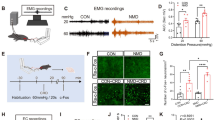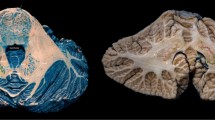Abstract
Knowledge about the central innervation of the lower urinary tract is limited. The spinal cord and the pontine micturition center have been investigated most thoroughly, whereas higher centers have received little attention. Pseudorabies virus (PRV), a self-amplifying and transneuronal tracer was injected into the bladder trigone of 21 Sprague-Dawley rats. The animals were killed after 72, 96, and 120 h. The whole CNS was sectioned and immunostained for PRV. CNS centers directly connected to the bladder include the intermedio lateral cell column, the central autonomic nucleus, and the nucleus intercalatus at the spinal cord levels T12–L2 and L6–S2. The raphe pallidus et magnus, the A5 noradrenergic area, the pontine micturition center, the locus coeruleus, the periaquaductal gray, the nucleus para- et periventricularis of the hypothalamus, the red nucleus, the medial preoptic area, and the cortex are supraspinal centers connected to the bladder. Lower urinary tract function is a complex multilevel and multineuronal interaction. It involves facilitation and inhibition at many levels of the CNS.
Similar content being viewed by others
Author information
Authors and Affiliations
Rights and permissions
About this article
Cite this article
Zermann, DH., Ishigooka, M., Doggweiler, R. et al. Central autonomic innervation of the lower urinary tract – a neuroanatomy study. World J Urol 16, 417–422 (1998). https://doi.org/10.1007/s003450050094
Issue Date:
DOI: https://doi.org/10.1007/s003450050094




